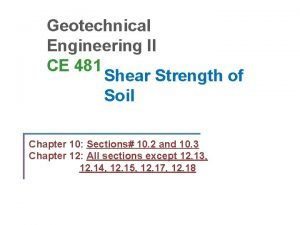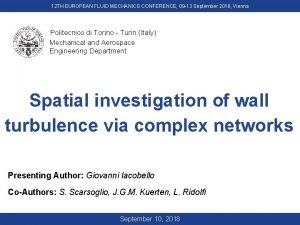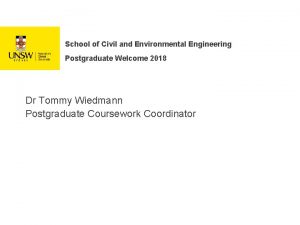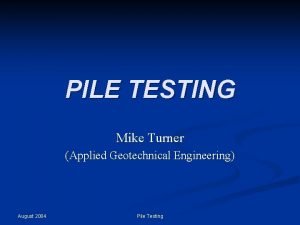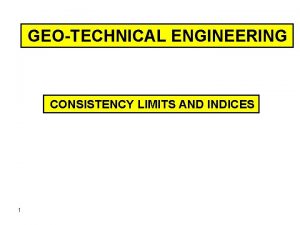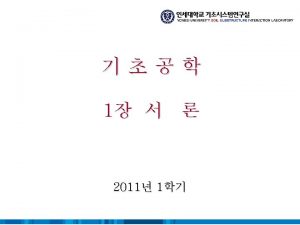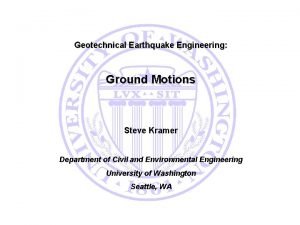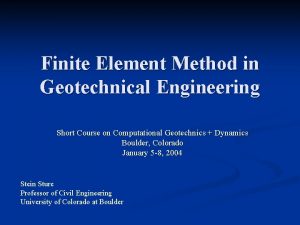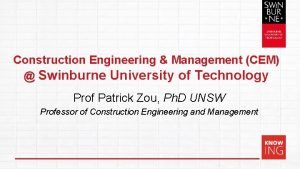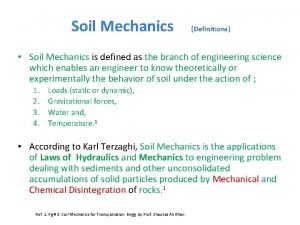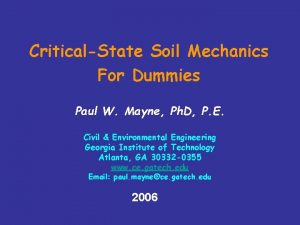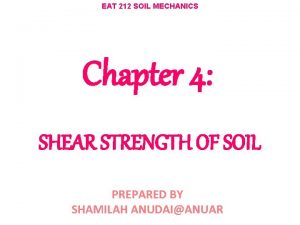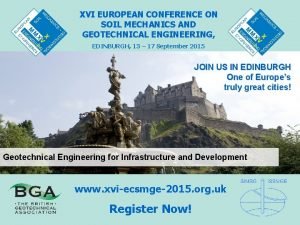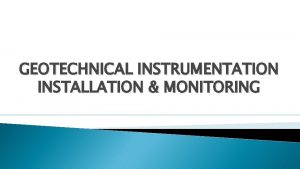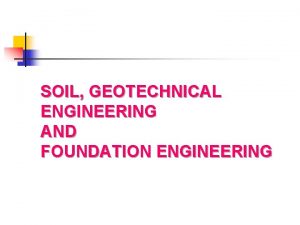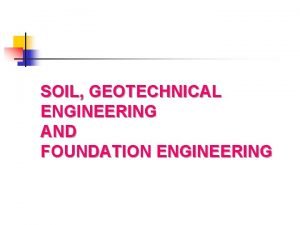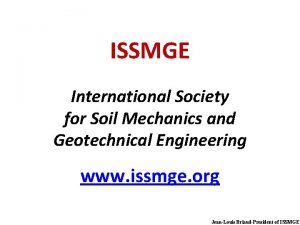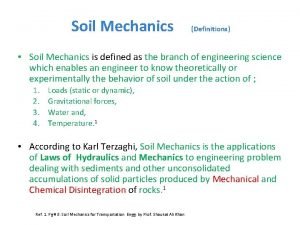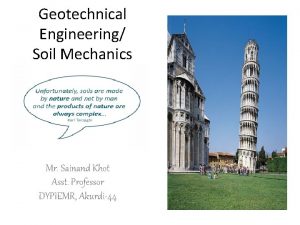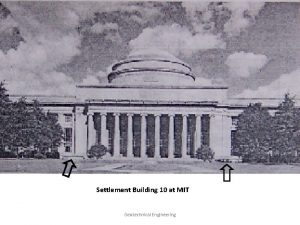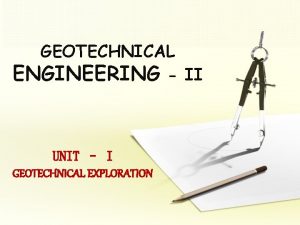XVI EUROPEAN CONFERENCE ON SOIL MECHANICS AND GEOTECHNICAL















- Slides: 15

XVI EUROPEAN CONFERENCE ON SOIL MECHANICS AND GEOTECHNICAL ENGINEERING, EDINBURGH, 13 – 17 September 2015 Corporate Associates Presidential Group – Breakout session www. xvi-ecsmge-2015. org. uk

Bridging State of the Art (SOA) and State of Practice (SOP) in Geotechnics • • • Welcome by ISSMGE President Professor Roger Frank CAPG plan of work - Introduction by CAPG Chair Mr Sukumar Pathmanandavel Presentation of SOA and SOP Professor Pierre Delage Findings of a recent TCs survey on SOA and SOP Valérie Bernhardt, Kim Chan, Chaido Doulala-Rigby (Yuli) Discussion with the floor Led by Karel Allaert

CAPG Organisation and Activities • Core team from Coffey, Terrasol/Setec, Tensar, GHD, Jan de Nul and Siemens, all Corporate Associates. A stable team, teleconferences held at 6 weekly intervals. • Strongly supported by the President, Roger Frank, and also the ISSMGE secretariat. Close collaboration with Technical Oversight Committee (TOC), through Pierre Delage. • Key activity over past 18 months has been work on implementation of the CAPG plan 2013 to 2017 (available on the ISSMGE web page). • Also, working on activities to increase the number of Corporate Associates

CAPG Plan 2013 to 2017 • Key purpose of the plan is to increase the interaction between academic and the commercial sector, for the betterment of the geotechnical profession and commercial practice. • The tool we have chosen to have this interaction is through conducting a survey of the State of the Art (SOA) and State of Practice (SOP) of geotechnical and geo-environmental engineering. • The form of the survey will be prepared using input and information from the ISSMGE Technical Committees (TCs) • The completion of the survey will be by 30 Influential companies in the world (reflecting practitioners/ users of practitioners view point). The results to be (hopefully) presented/ published at the 2017 Seoul Conference.

State of the Art – State of Practice: two “virtual” objects (1) • SOA: we know through papers, conferences, books and discussions with experts that people know many things on a given subject; we have an idea of existing knowledge • We need the knowledge of knowledge • We also know that frontiers exist and should be overpassed by research • SOA reports prepared for conferences (including TC conferences) highly depend on the author’s personality. They can be: • • Quite personal, mainly centred on the author’s own contributions with some references to colleagues, either through books or SOA conference paper Wider, with quite a complete panorama, either through a book (e. g. Mitchell and Soga 2005 on soil microstructure) or a SOA conference paper (e. g. Alonso, Gens and Hight on Unsaturated soils, ECSMGE Dublin 1998) • Many fields have no SOA reports providing updated SOA (we have a feeling of what could be the SOA but there is no report) • TCs are the place where experts contribute to develop knowledge in an interactive manner in a given field (through Conferences, workshops, . . ) • 10 i TCs are more fundamental and more prone to provide SOA reports (see questionnaire report)

State of the Art – State of Practice : two “virtual” objects (2) • SOP: we know how people solve practical problems in a given field through papers, conferences, books, discussions with practitioners and final achievements • Practical problems solving includes: • • Conception Calculation Execution Measurements and feedback • • Books (mainly for basic problems like foundations, retaining structures, …) Guidelines provided by various institutions including 20 i TCs devoted to practical applications SOP reports from conferences, when they exist; Codes of practice (UK) Short courses proposed by some 20 i TCs (e. g. TC 211 on Ground improvement), by some universities and continuing education organisations • Good knowledge of SOP is essential to practitioners in their field • SOP can be partly caught through: • Standards have a particular role: • • • They can be open and allow for extension and new developments (Eurocodes) They can be straight and restrict new developments National cultures and administrations are also important in either allowing or restraining developments, including law issues • Some problems have no standards, guidelines… but rely on extensive interaction between scientific research, technical innovation and practice • • Large structures involving high risks: dams (ICOLD), radioactive wastes (National waste agencies) Innovative issues: offshore geotechnics, energy geotechnics (hydrate bearing sediments)

Presentation of the results of the TC survey Aim of the survey issued by CAPG to TCs • Gain better understanding of the state of the art (SOA) and the state of practice (SOP) of various geotechnical practices. • In order to be able to identify main areas of possible improvements in the SOP to help advance the geotechnical engineering profession towards state of the art in geotechnical practice. TC survey issued in January 2015. By the end of February 2015, we had received 25 answers (out of 32 TCs in total). Thanks a lot to TCs for their interest and involvement. This lead CAPG to organise this breakout session in Edinburgh because the survey results highlighted that it is necessary to have a discussion/debate between TCs and CAPG in order to identify the areas of possible improvements.

Presentation of the results of the TC survey Questions about existing situation within each TC

Presentation of the results of the TC survey Questions about existing situation within each TC Questions 5, 7 et 8 to be detailed in the following slides.

Question 5: Are there any significant gaps between SOA and SOP in the area of interest of your TC ? Response summary: • TC responded: 25 • Yes: 16 • No: 9 Selected responses: “There are no knowledge gaps, but challenge is to disseminate the SOA to practitioners. ” “Gaps are due to inertia of practitioners/industry. ” “Implementation is a high cost at the beginning, but highly competitive at the end. ” “SOA (except for recent developments) is for the most part already incorporated in relevant International Codes. ” Most TC 10 x comment on their TCs being mainly academic/research oriented (and thus having few relations with practitioners). A few TC 20 x and TC 30 x comment on good overlapping of research and practice in their field.

Question 7: Are there needs to close the gaps between SOA and SOP within your TC? Response summary: • TC responded: 25 • Yes: 16 • No: 7 • Yes/No: 2 Selected responses: “It depends on the way that national and international institutions are capable to recover the SOA-knowledge in the engineering practice. ” “There is a need to facilitate the dissemination of the SOA to practitioners. ” “There is a need to exchange experience and culture. ” “Even though we lack documents specifying SOA and SOP, the point of our TC is to educate the community and bring the SOA into practice. ” “We have always paid attention to maintaining a good connection between SOA and SOP”

Question 8: Are there key technical topics of TC that CAPG should concentrate its efforts on? Response summary: • TC responded: 25 • Yes: 19 • Possible: 3 • No: 3 • Key TC technical topics and CAPG Actions: “Use of knowledge gained from research to be used in engineering practice” CAPG to help bridging the gap between research and engineering practice – CAs are not aware of most of the work carried out by the TCs; CAPG to investigate and implement with TCs efficient ways of communicating TCs wider activities to practitioners – good example TC 211 “Lack of digital infrastructure to reach the Industry; need for Geotechnical ‘Apps’ – including sustainability ‘apps’ such as CO 2/embodied energy apps CAPG to investigate with Academicians the possibilities and a possible way to ‘fill’ some of the generic gap – e. g. real time monitoring apps, simple design apps

Question 8: Are there key technical topics of TC that CAPG should concentrate its efforts on? “Wider use of numerical modelling in practical geotechnics (see comment) – e. g. modelling deformation, unsaturated soils, suctions etc” This is quite a tricky one and CAPG would need suggestions from the TCs and the CAs on how numerical modelling can widely be embedded/adopted and benefit practical, real time applications “Promotion/adoption of non-traditional methods and materials in transportation – e. g. rail/pavements+geosynthetics. ” CAPG to help lobbying the use of geosynthetics (see comment) with various specifiers/asset owners through its memberships/connections – e. g. UK Df. T contact via IGS UK, through Fed. IGS etc “Spread waste management and pollution control knowledge in least developed countries. Address key environmental impacts from new energy sources like biogeotechnology, shale gas, geothermal, Aeolian, wave, solar etc” CAPG to recruit and connect new and existing CAs practitioners in this field with TC 215 and possibly Red. R and Engineer’s without Borders/others? ,

CA’s problems encountered in the field regarding geotechnics • Protection of intellectual property • Companies look for solutions/calculations/practical working methods while working on a certain job => increase of lead on the competition • Knowledge stays within the company • Area of tension between companies and academic world • Standards vs empirical practises • Correct use of (local or international) standards • Companies working in very specialised fields sometimes want to “overrule” existing standards because they see other phenomena happening • E. g. hydraulic fills with crushable sands in dredging industry and their acceptance criteria via CPT-Dr relationships • Acceptance of innovation/cost-effective measures • Companies like to think “out of the box” • Prove/justification of solutions cannot be given via existing standards • Own feedback is not accepted by client/consultant

CA’s problems encountered in the field regarding geotechnics • Solutions • Mind setting of companies, academic world, consultants. . . in executing a job with an open and constructive attitude to each other. • Seen the questionnaire, answered by most of the TC’s, many TC’s are tackling this “communication problem” already. • Still, the communication to the outside world mostly stops at the borders of ISSMGE • Could CAPG be a catalyst in this conversation!?
 Shear strength of soil in geotechnical engineering
Shear strength of soil in geotechnical engineering European fluid mechanics and turbulence conference
European fluid mechanics and turbulence conference Master of civil engineering unsw
Master of civil engineering unsw Applied geotechnical engineering
Applied geotechnical engineering Geotechnical data management
Geotechnical data management Geotechnical data management
Geotechnical data management Consistency limits in geotechnical engineering
Consistency limits in geotechnical engineering Geotechnical
Geotechnical Geotechnical earthquake engineering kramer
Geotechnical earthquake engineering kramer Finite element method in geotechnical engineering
Finite element method in geotechnical engineering Swinburne civil engineering
Swinburne civil engineering Living soil vs dead soil
Living soil vs dead soil What are the four spheres of the earth
What are the four spheres of the earth Soil mechanics definition
Soil mechanics definition Critical state soil mechanics for dummies
Critical state soil mechanics for dummies Vane shear test advantages and disadvantages
Vane shear test advantages and disadvantages
